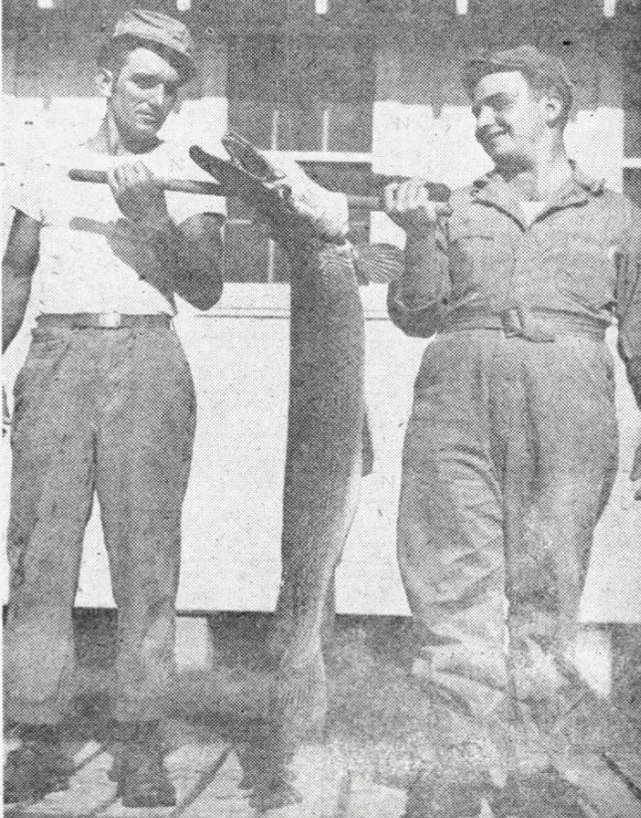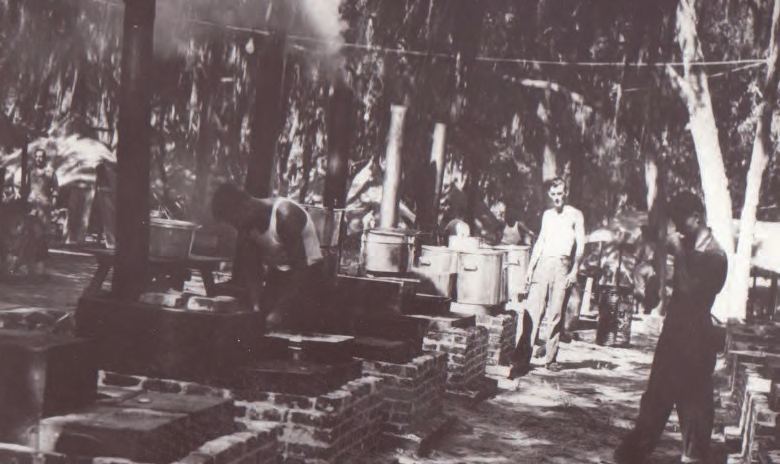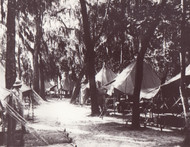The Early Days of Keesler Field: Biloxi's Stomping Grounds
Posted by Paige Gutierrez on Dec 6th 2023
PHOTO: Tents provided the first housing for troops of Keesler Field in 1941. Joe Scholtes Collection, Biloxi Library Local History and Genealogy Collection.
This article originally written by Paige Gutierrez with the title "Alligator Gars and Spanish Moss: Early Keesler Field". Paige is a local Biloxi writer for BNews Monthly, the monthly newsletter of the City of Biloxi. Photographs courtesy of the LHG Image Collection / Local History & Genealogy Department / Harrison County Library System unless otherwise specified.
A New Record
 On October 29, 1941, the The Keesler Field News reported a record set for Biloxi’s new Army Air Force base:
On October 29, 1941, the The Keesler Field News reported a record set for Biloxi’s new Army Air Force base:
Using a 250-test pull hand line and a three-inch shark hook, Corp. Albert T. Niccolai of the 413th Squadron last week bagged the largest alligator gar ever caught by a Keesler Field soldier.
The 6-foot fish, weighing 120 pounds, took about 20 minutes to land and had to be slugged before the night was over. It was caught at the Southern Shell Company pier in the Back Bay of Biloxi, east of Keesler Field, late at night after several hours of fishing in which the corporal also caught a smaller gar weighing 60 pounds and an 85-pound sand shark.
Corporal Niccolai‘s huge fish was one of many entered in Keesler’s alligator gar tournament, open to all Keesler soldiers. These gars were described as “large prehistoriclooking fish” that were sometimes mistaken for alligators in the water.
The newspaper further reported:
The tournament, smacking more of the old-time wild west rodeo in excitement, had no restrictions placed on the manner of catching the fish and no holds barred, even to lasso coming into play. In landing, however, the rules barred shooting the fish.
The soldiers used rods and reels, throw lines, spears, bows and arrows, and, at night, flares. For most of them it was their first taste of such fishing, and they made the most of their opportunity. The waters fished were Bay of Biloxi, Bayou of Bernard, Biloxi River, Tchouticabouffa River, Fort Bayou and its tributaries, and the Mississippi Sound from Gulfport to Ocean Springs.
Prizes were given every two weeks for the heaviest fish, and every month for the greatest number caught. A lieutenant colonel donated the grand prize: “a handsome silver trophy, inscribed with the name of the winner.”
PHOTO: “Here’s proof that these soldiers weren’t telling a ‘fish story.’ It’s a 60-pound, 54-inch alligator gar fish. The big gar, a common fish in these waters, was caught in Back Bay on a 40-pound test line with mullet bait. It took 36 minutes to land him.” KFN Photo, April, 1945.
Fisherman’s Paradise
The Keesler newspaper told troops that “our Back Bay is a real fisherman’s paradise, with brackish water with tarpon, speckled trout, white trout, redfish and more. From the standpoint of the Army, this is one of the few military posts in the country where many kinds of fish can be caught from the reservation itself — from the elusive speckled trout to the fighting tarpon, which will drag — yes — your skiff about the bay!”
 But this paradise was impacted by the overgrowth of the voracious alligator gar that decimated game and other fish populations in local waters. The tournament was encouraged by fish and wildlife officials to help reduce the numbers of the alligator gars. Alligators, the natural predators of alligator gars, had been overhunted in response to demand by high-end fashion houses for valuable alligator skins. Fish and wildlife officials warned that fewer alligators meant more alligator gars.
But this paradise was impacted by the overgrowth of the voracious alligator gar that decimated game and other fish populations in local waters. The tournament was encouraged by fish and wildlife officials to help reduce the numbers of the alligator gars. Alligators, the natural predators of alligator gars, had been overhunted in response to demand by high-end fashion houses for valuable alligator skins. Fish and wildlife officials warned that fewer alligators meant more alligator gars.
PHOTO: “Outdoor cooking was first kitchen set up before mess halls were built. For a while, every day was barbecue day.” Joe Scholtes Collection, Biloxi Library Local History and Genealogy Collection.
Under Spanish Moss
When the gar rodeo started, Keesler Field was new, and construction was far from complete. Troops lived in open-air tents among the heavily mossed oaks on Back Bay. Cooking was outdoors among the trees, and church services were held “outdoors ‘neath the hanging Spanish moss.” For many soldiers from other parts of the country, this was an unusual, even exotic setting, especially with the unfamiliar hanging moss, much more abundant then than today. A cartoon series entitled “Spanish Moss” in The Keesler Field News satirized life on the new base. One such cartoon refers to the alligator gar tournament: See cartoon above left on the previous page.
###
Hungry for shrimp? Visit our Shop page to order wild-caught Gulf shrimp to be shipped to anywhere in the country today!

